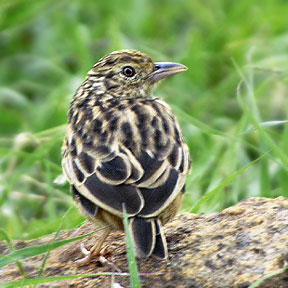The park stretches over 874 square kilometres (337 sq mi), protecting the wildlife of Karnataka. Together with the adjoining Nagarhole National Park (643 km2 (248 sq mi)), Mudumalai National Park (320 km2 (120 sq mi)) and Wynad Wildlife Sanctuary (344 km2 (133 sq mi)), it forms the largest protected area in Southern India, totaling 2,183 km2 (843 sq mi). It is notable as the home to around seventy Bengal tigers and over three thousand Indian elephants (in 1997 ) Bandipur is part of the Nilgiri Biosphere Reserve.
The Western Ghats, Nilgiri Sub-Cluster (6,000+ km²), including all of Bandipur National Park, is under consideration by the UNESCO World Heritage Committee for selection as a World Heritage Site.
There are also several notable flowering and fruiting trees and shrubs including: Kadam tree Adina cordifolia, Indian gooseberry Emblica officinalis, Crape-myrtle Lagerstroemia lanceolata, axlewood Anogeissus latifolia, Black Myrobalan Terminalia chebula, Schleichera trijuga, Odina wodiar, Flame of the Forest Butea monosperma, Golden Shower Tree Cassia fistula, satinwood Chloroxylon swetenia, Black Cutch Acacia catechu, Shorea talura (E), indigoberry Randia uliginosa.
Threatened species
Tiger, Four horned Antelope, Gaur, Elephant, Panther, Sloth Bear, Crocodiles, Mouse deer, Python, Osprey,
Birds
Grey Junglefowl, Pompadour Green Pigeon, Honey Buzzard, Red-headed Vulture, Grey-headed Fish Eagle, Brown Hawk Owl, Bay Owl, Malabar Trogon, Nilgiri Flycatcher, Malabar Pied Hornbill, Little Spiderhunter, Peacock, Plain Flowerpecker and Woolly-necked Stork can be seen at B.N.P..
Reptiles
King Cobra, Common Cobra, Python, Adder, Viper, Rat Snake, Water Snake, Marsh Crocodile, Lizard, Chameleon, Monitor Lizard, Frog, Tree frog, Toad and Tortoise.
Insects
Butterflies
Common Rose, Crimson Rose, Common Jay, Tailed, Lime Butterfly, Malabar Raven, Common Mormon, Red Helen, Blue Mormon, Southern Birdwing, Common Wanderer, Mottled Emigrant, Common Grass Yellow, Spotless Grass Yellow, One spot Grass Yellow, Nilgiri Clouded Yellow, Common Jezebel, Psyche, Common Gull., Caper White or Pioneer, Small Orange Tip or Lesser Orange Tip, White Orange Tip, Large Salmon Arab, Common Evening Brown, Great Evening Brown, Common Palmfly, Common Bushbrown, Glad Eye Bushbrowm, Red Disk Bushbrown, Red Eye Bushbrown, Lepcha Bushbrown, Nigger, Common Threering, Common Fourring, Common Fivering, Tawny Coster, Rustic , Common Leopard, Indian Fritillary, Common Sailer, Colour Sergeant, Chestnutstreaked Sailer, Grey Count, Red Baron or Baronet, Angled Castor, Common Castor Aridane merione, Yellow Pansy, Lemon Pansy, Peacock Pansy, Chocolate Pansy, Orange Pansy, Blue Pansy, Grey Pansy, Blue Admiral, Glassy Blue Tiger, Blue Tiger, Dark Blue Tiger, Plain Tiger, Striped Tiger/ Common Tiger, Danaid Eggfly, Great Eggfly, Common Crow, Brown King Crow, Common Pierrot, Angled Pierrot, Banded Blue Pierrot, Striped Pierrot, Dark Pierrot, Red Pierrot, Lime Blue, Zebra Blue, Gram Blue, Common Cerulean, Tiny Grass Blue, Dark Grass Blue, Indian Cupid, Large Four-Line Blue, Common Silverline, Plum Judy, Plain Scupid, Pea Blue, Metallic Cerulean, Chestnut Bob, Dark Palm Dart, Brown aw1
Ants
Anenictus sp1, Anoplolepis longipes,Camponotus parius, Crematogaster biroi, Crematogaster sp 1*, Crematogaster sp 2*, Diacamma rugosum, Lepisiota capensis,Leptogenys chinesis, Leptogenys coonorensis, Leptogenys diminuta, Lophomyrmex quadripinosus, Meranoplus bicolor, Monomorium indicum, Myrmicaria striata, Myrmicaria brunnea, Oligomyrmex wroughtonii, Pachycondyla sp1*, Paratrechina sp1*, Pheidole sharpi, Pheidole sp1*, Pheidole sp2*, Pheidologeton diverus, Polyrhachis exercita, Solenopsis geminate, Tetraponera rufonigra, Tetraponera sp1* (* New species yet to be identified.)
Dung Beetles
Catharsius granulatus *, Copris indicus *, Oniticellus cinctus*, Onitis singhalensis *, Onthophagus beesoni*, Onthophagus ensifer *, Onthophagus rana *, Onthophagus sp.107* #, Onthophagus tarandus*, Picnopanaleus rotundus, Caccobius diminutives, Caccobius ultor, Copris furciceps, Copris sp.1#, Heliocopris dominus, Pseudonthophagus sp.2#, Sisyphus neglectus, Caccobius inermis, Caccobius meridionalis., Caccobius torticornis, Caccobius sp.1#, Copris sodalist, Onthophagus socialis, Onthophagus sp.301#, Onitis phelemon, Onthophagus furcillifer, Caccobius gallinus, Onthophagus rufulgens, Onthophagus sp.302#, Copris repertus, Pseudonthophagus sp.1#, Copris davisoni, Onitis falcatus, Onthophagus turbatus, Copris imitans, Onthophagus quadridentatus, Caccobius vulcanus, Liatongus affinis, Oniticellus spinipes, Sisyphus longipus, Onthophagus dama (* Eextremely rare (Represented by a by a single specimen in the collection), # New species yet to be identified.
Himavad Gopalaswamy Betta
Himavad Gopalaswamy Betta in the core zone can be accessed by a small road through the village of Hangala north of the national park. Gopalaswamy Betta (betta is hill in Kannada) located inside the forest is a popular trekking spot. There is also a motorable road to the summit of the hill. The area is also frequented by herds of wild elephants. The hill gets its name Himavad (fog in Kannada) due to the fog during most parts of the year. Atop the hill is a temple of Lord Venugopala Swamy built centuries ago and a travellers' bungalow which remains locked now and belonged to the Ruler of Mysore. Nobody is allowed to stay beyond 5:30 PM. These hills are covered with grass and classified as shola forests.
Elephants which traditionally migrate from dry to moist zones now increasingly come into contact with human habitations and farms are often damaged. Sugarcane crops are particularly attractive to them. Of late, the road has been a major concern as speeding vehicles have killed many wild animals in spite of frequent warnings to travelers from the forest department officials.

















































No comments:
Post a Comment